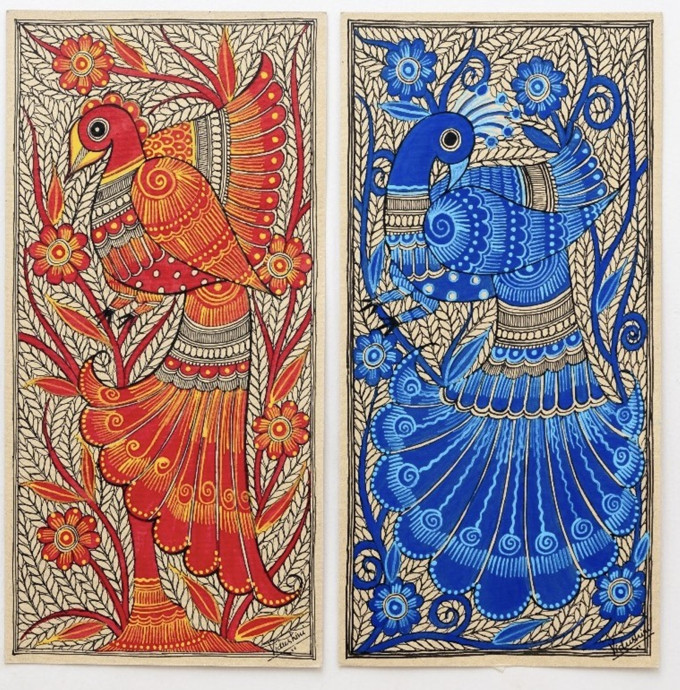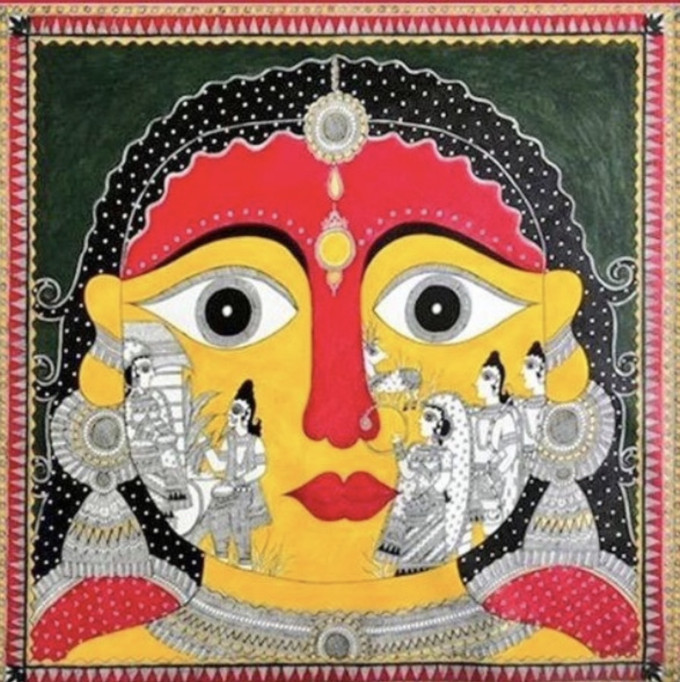Ancient strokes, modern canvases: How women artists lead Madhubani paintings’ global rise
“It happened in front of me,” Padma Shri award-winning artist Manu Parekh tells indianexpress.com, while discussing the evolution of Madhubani paintings from wall art to paper. This transition, he says, began in 1965 when Bhaskar Kulkarni, an Indian government aid worker, visited the Mithila region in Bihar from Delhi.
Kulkarni proposed the innovative idea of adapting traditional wall paintings to paper. To facilitate this shift, the government provided artists with necessary supplies, including paper and colours, at no cost. Parekh, at that time, used to work for Pupul Jayakar, an Indian cultural activist, art historian and writer, at the All India Handicrafts Board (AIHB). It was Jayakar who directed Kulkarni to visit Mithila after then Prime Minister Indira Gandhi insisted “do some artwork in Bihar”. The artwork produced through this initiative was then marketed and sold through government-operated handicraft stores across India, introducing Madhubani art to a broader audience, as per the Madhubani Art Centre.

In the modern context, Madhubani paintings have found their way onto canvas, paper, fabric, and even digital mediums.
Predominantly practised by women, this art form has not only survived centuries but also evolved to remain relevant in the contemporary art world. “Madhubani art is not just a form of expression, but a vital cultural asset of the Mithila region. It reflects the region’s rich traditions, folklore, and mythology, and serves as a living repository of Mithila’s cultural heritage,” says Madhubani artist Vidushini Prasad. By continuing this artistic tradition, artists ensure that these cultural tales and practices are passed onto future generations.
 Madhubani painting plays a crucial role in preserving and promoting the cultural heritage of the Mithila region. (Source: Vidushini Prasad)
Madhubani painting plays a crucial role in preserving and promoting the cultural heritage of the Mithila region. (Source: Vidushini Prasad)
Women artists: The backbone of Madhubani painting
“Women have been the primary custodians of Madhubani painting since its inception. This art form was passed down from mothers to daughters, with each generation adding its own unique touch while preserving traditional techniques and motifs,” explains Manisha Jha Mishra, National awardee in Mithila paintings.
Historically, the women of Mithila painted the walls and floors of their homes with intricate designs to mark special occasions and festivals.
In the present day, women continue to dominate the field. Many have gained national and international recognition for their work, breaking social barriers and establishing themselves as successful artists and entrepreneurs. Madhubani painter Ganga Devi is a prime example. “Ganga Devi became a celebrity,” says Mishra, especially after Tokio Hasegawa, director of Mithila Museum, Japan, visited India in 1972 after being in awe of one of her paintings he came across through a tourist there.
“Women artists like me promote Madhubani art through workshops, exhibitions, and social media, making it accessible to a global audience. I run one of the largest Facebook communities around Madhubani, with more than 35,000 members; most of the members are women across India and outside,” Prasad says.
View this post on Instagram
A post shared by Manisha Jha Mishra (@manishajha.artfyi)
“Women have become technology savvy, creating their paintings and posting on social media. I am seeing many rural women also getting into reel creation. This has empowered these women. During Covid when no events or exhibitions were happening, many women artists used social media platforms to sell their work and survive,” she says.
Balancing tradition and innovation
One of the greatest challenges facing Madhubani artists today is balancing the preservation of traditional elements with innovation to create unique fusion styles that resonate with modern art enthusiasts while respecting their artistic heritage. According to Mishra, understanding symbolism and culture is crucial for advancing this art form.
Many artists, like her, have found ways to achieve this balance by integrating traditional motifs and techniques into works that address contemporary issues or aesthetic tastes. “The culture remains constant, but the world around us changes. My work reflects the connection between these two worlds,” she explains.
Some artists experiment with new color palettes and materials while maintaining Madhubani art’s distinctive style and symbolism. Prasad emphasises, “I preserve traditional themes and techniques while incorporating vibrant colors and contemporary designs to appeal to urban and global audiences.”
However, Parekh offers a different perspective: “Madhubani art is folk art rooted in tradition. There is no need for additional variety when a woman sees her mother’s work. They are not modern painters.”
He stresses the importance of understanding and deepening cultural roots for artistic progress: “The more one understands their mother’s art, the greater their advancement. It’s individual-dependent, reflecting our profound cultural heritage.”
 Japan has a dedicated museum for Madhubani paintings (Source: Vidushini Prasad)
Japan has a dedicated museum for Madhubani paintings (Source: Vidushini Prasad)
Challenges and opportunities in the contemporary landscape
Madhubani art faces several challenges in the modern art market. One of them is that folk artists still get looked down upon as compared to modern or contemporary art. “Most galleries don’t entertain folk art and displaying in galleries is a big challenge,” Prasad says.
Ridhima Srivastav, founder at Weave Hand, an online marketplace that supports artisans making hand-made products, notes, “balancing the preservation of traditional methods and themes with the demands of the commercial art market can be challenging.” She states, “There is a risk of losing the authenticity and cultural significance of the art form in the pursuit of profit.”
“Segregation” is a big problem, according to Mishra. “Outside India, Madhubani paintings aren’t categorised as folk art. They’re recognised simply as art. And when it’s viewed as art, it’s appreciated for its artistic merit, without labels or classifications.”
However, these challenges are accompanied by numerous opportunities. One of the most significant changes in Madhubani art has been its commercialisation. “In contemporary times, Madhubani art has evolved into a global art form, transcending caste distinctions and geographical boundaries. It is no longer confined to the walls of homes in Mithila,” says Srivastav, who works extensively with Mithila artists.
The growing global interest in indigenous art forms has opened up new markets for Madhubani paintings. E-commerce platforms have made it easier for artists to reach customers worldwide, bypassing traditional middlemen. “Exhibitions, workshops, and collaborations with global artists and institutions have helped spread awareness and appreciation of this traditional art form. This international presence has also opened up new markets and opportunities for Madhubani artists,” says Mithila painter Yanshika Priya.
📣 For more lifestyle news, click here to join our WhatsApp Channel and also follow us on Instagram
Disclaimer: The copyright of this article belongs to the original author. Reposting this article is solely for the purpose of information dissemination and does not constitute any investment advice. If there is any infringement, please contact us immediately. We will make corrections or deletions as necessary. Thank you.
